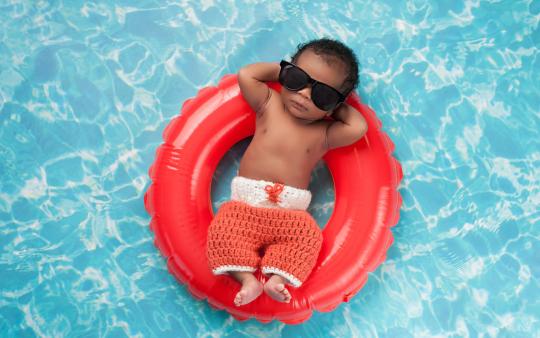Wondering about sunscreen use in young babies? Baby skin doesn’t fully mature until about 32 weeks after a baby is born—and even later if the baby is premature. So that ridiculously soft skin is sensitive to the sun and anything you might put on it, even infant sunscreen. But there is so much benefit and fun to be had in the great outdoors! You can find a balance between catching those healthy rays and protecting your little one’s skin with a little vigilance and lots of know-how.
INFANT SKIN AND SUNSCREEN USE
When spending substantial time in the sunshine, a natural sunscreen for children and adults should be used but it is typically not recommended for babies under 6 months of age because of baby skin’s fragility and permeability. Sunscreen on a baby’s skin can, at the very least, result in a rash or irritated, dry and cracked skin that may result in infection, and can, at worst, lead to systemic chemical toxicity.
SUNSCREEN SELECTION FOR BABIES
Choose mineral-based sunscreen
Again, for babies under 6 months, it is highly recommended that you avoid using sunscreen, period. If sunscreen must be used, look for a mineral-based product containing zinc oxide or titanium dioxide and limit its application to only the hands and face, taking care to keep the sunscreen out of your little one’s eyes and discontinue if any skin irritation develops. Mineral-based sunscreen provides a physical barrier that works by reflecting the UV rays and is minimally absorbed through the skin, unlike the rapidly absorbed chemical-based options.
Avoid SPF over 50
Choose a sunscreen with a sun protective factor (SPF) of at least 15 but not greater than 50. Sunscreens with greater than SPF 50 give a false sense of sun protection as the increased SPF is only marginally more effective but may lead consumers to believe that less frequent application is necessary.
Go for broad-spectrum coverage
Look for broad-spectrum baby sunscreens that protect from the burning power of UVB and the cancer-causing potential of both UVB and UVA radiation.
Testing and timing of sunscreen on babies
Always test the sunscreen on a small patch of skin at least one day in advance before using more liberally to make sure her tender skin does not react. Be proactive and apply at least 30 minutes prior to sun exposure and re-apply at least every 2 hours when playing outdoors, regardless of the SPF.
Water-resistance
You don’t need a water-resistant sunscreen if your infant will not be going in the water nor will she likely be sweating the sunscreen off. But as your baby grows up–as they quickly do!–and starts running around and splashing in the lake or ocean, look for a sunscreen containing beeswax or oils like shea butter or sunflower oil to provide some natural water-resistance. Alternatively, the Environmental Working Group rates cetyl dimethicone as low-hazard and you can check out their comprehensive list of top-rated sunscreens.
SUNSCREEN INGREDIENTS TO AVOID
Chemical sunscreen ingredients such as avobenzone, oxybenzone, octocyrlene, and ecamsule have been shown to be absorbed through the skin into the blood in both children and adults and can potentially disrupt hormones. The higher surface area-to-body weight ratio and higher absorption rates of babies and children mean the chemicals can bioaccumulate at a higher rate in their little bodies and cause a more toxic effect.
Another ingredient to stay clear of is PABA and its derivatives, as they cause rashes and can facilitate easy burning.
You also want to avoid spray-on sunscreen products as they don’t ensure proper skin coverage (they must still be rubbed on the skin with your hands!) and they also pose a risk for inhalation, which can cause lung problems down the road.
Lastly, be mindful of the laundry list of inactive ingredients–natural or chemical–any ingredient can irritate and be absorbed through your infant’s precious skin.
THINKING BEYOND SUNSCREEN FOR BABIES
We have an important and dynamic relationship with the sun and UV rays are necessary for us to make vitamin D, which has important effects on our mood, our bones, our immune system, and our hormones. By using sunscreen, the UV rays are blocked and too much avoidance can increase the risk of vitamin D deficiency, to which babies are particularly susceptible. Be sure to discuss supplementing your baby’s diet with vitamin D with your health care provider.
Skin produces melanin, a pigment that protects it from UV light. But that fresh baby skin makes less melanin than adults’, making it more susceptible to UV damage. And even though people who produce more melanin may burn less from those toasty UVB rays, they are still susceptible to the damage caused by deeper UVA radiation. Frequent sunburns and excessive sunlight exposure in childhood strongly correlate with melanoma, a fatal type of skin cancer, later in life, so protecting baby’s skin from UV radiation is crucial in these first months.
The best ways to protect baby’s skin
- Put the protective power in your baby’s clothing! Dress them in hats, lightweight long-sleeved shirts and pants, use baby sunglasses, and look for clothes with UPF (ultraviolet protective factor) ratings.
- Plan outdoor activities for early morning and late afternoon when the sun is lower in the sky.
- And of course, enjoy the sheltering care of nature and hang out in the shade (thank you, trees!).
ALL-SEASON, ALL-DAY INFANT SUN PROTECTION
It is common sense to use sunscreen and other protection in the summer, but also consider it in the winter, especially if you are playing on reflective surfaces like snow, sand, ice, or water, or exploring high elevations. In North America the sun’s UVB rays are generally strongest between 10 am and 4 pm from April through October, depending on where you are; the closer to the equator you adventure, the stronger the rays for a longer duration of the day. But UVA radiation is consistent throughout daylight hours and can penetrate clouds and glass, so be mindful of protecting baby’s skin every day of the year, rain or shine.
WHEN BABY GETS TOO MUCH SUN
Sunburn
Burns happen—almost to the point of being a summer rite of passage (but it shouldn’t be!)—but burns are especially bad for a baby. If your baby’s skin is starting to look even a little pink, get out of the sun! The discomfort of a sunburn can take hours to appear and result in days of red, hot, itchy, blistery misery. If the worst happens and skin becomes pink, try some cooling compresses, tepid baths, or applying pure organic aloe vera gel to help soothe and repair. For severe burns (redness, swelling, blisters, fever) or signs of overheating be sure to seek medical help immediately.
Overheating
Since a baby’s skin is not fully developed, they have a hard time regulating their temperature, and can suffer either a high rate of heat loss or overheating, putting them at high risk for heat stroke, so make sure the clothes you put on your baby don’t allow them to become overheated and ensure they are receiving adequate hydration from breastfeeding, bottle feeding, or plenty of water from a cup if baby is weaning. Prompt medical treatment is needed if you see any of these heat related signs in a baby, child, or adult:
- elevated temperature
- hot dry flushed skin
- weakness
- dizziness
- nausea
- rapid breathing and heartbeat
- loss of consciousness
- no sweating
- seizure
Don’t be afraid to enjoy the outdoors and play in the sun with your infant with these recommendations in mind. Safeguard the whole family with lightweight protective layers, mineral-based sunscreen, and shady places. Take measures to keep cool, stay hydrated, and find all the pleasures the sun can give you!
Extra resources about sunscreen safety
- Skin Cancer Foundation: Sun Protection for Infants
- Skin Cancer Foundation: UVA & UVB
- Skin Physiology of the Neonate and Infant: Clinical Implications
- Healthline: Worried About Chemicals in Your Sunblock? Here’s 5 Derm-Approved Options
- American Academy of Dermatology: Sunscreen FAQs
- FDA: Should You Put Sunscreen on Infants? Not Usually
- EWG’s 13th Annual Guide to Sunscreens






